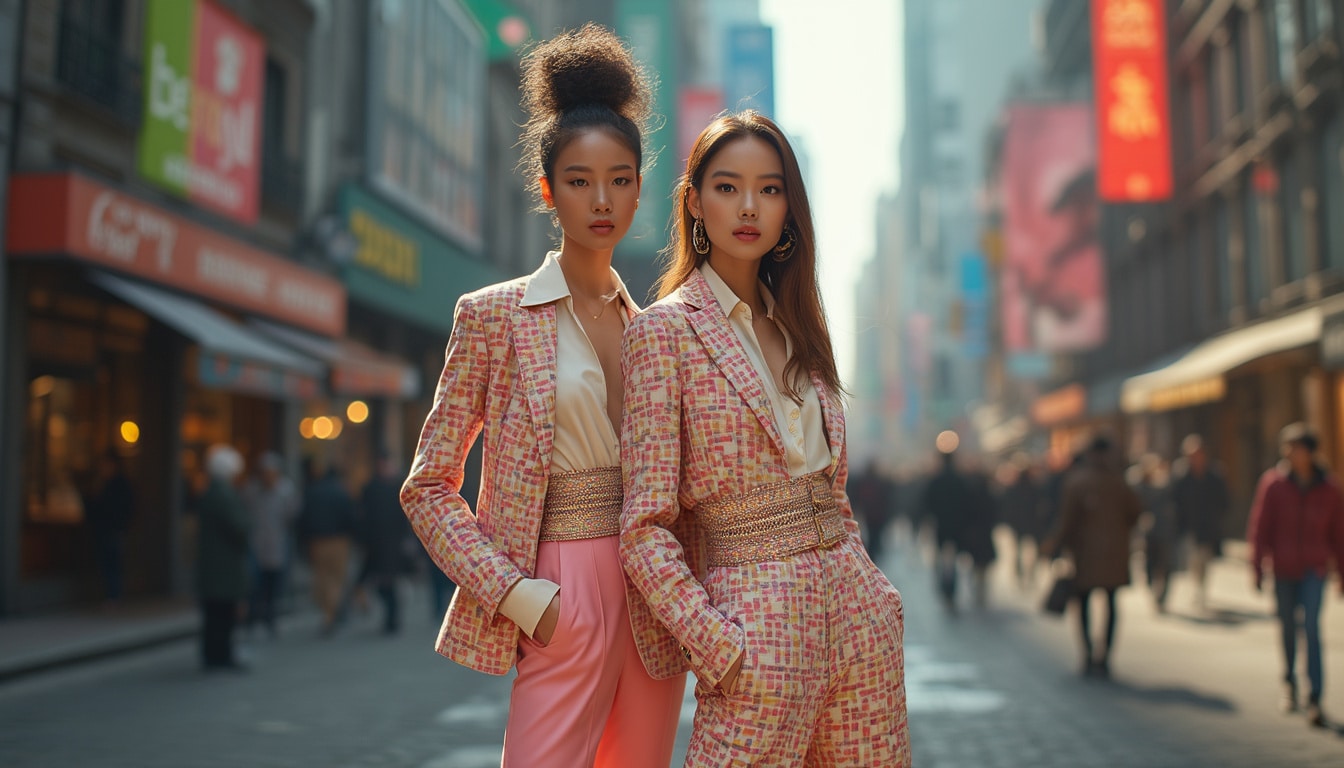« `html
The fashion runway just got a high-tech makeover. H&M is stepping into the future with digital twins for their models. This bold move is reshaping creativity in unexpected ways.
In an era where artificial intelligence seamlessly blends with creativity, H&M is pioneering the use of digital avatars for their fashion shows. These sophisticated algorithms craft lifelike twins of human models, pushing the boundaries of what’s possible in the industry. Imagine a world where every new collection can be instantly adapted and showcased without the logistical hassles of traditional photo shoots. These virtual models not only mimic the exact poses of their human counterparts but also adapt dynamically to the visions of designers. This fusion of technology and fashion trends is set to challenge long-held conventions and spark intriguing debates about the future of the industry. As H&M continues to explore this innovative path, the question remains: can fashion thrive without the human touch? Consumers are beginning to embrace these digital faces, signaling a possible shift in how we perceive and engage with style.
Embracing digital twins could revolutionize fashion campaigns, offering unprecedented flexibility and cost savings. By reducing the need for physical models, brands can allocate resources more efficiently and experiment with creative concepts without the usual constraints. However, this technological leap brings forth concerns about authenticity and the social impact of replacing human presence with digital alternatives.
You might also like this article:
The Ethical and Social Implications of AI in Fashion
The introduction of digital twins by brands like H&M raises significant ethical questions. Creating avatars that perfectly mirror real models touches on issues of self-image and body representation. Experts warn that this could exacerbate existing unrealistic beauty standards promoted by the industry. Additionally, the rise of digital models may impact the employment opportunities for human models, fundamentally altering the way we consume and interact with fashion.
You might also like this article:
The Future of Digital Twins in Fashion Shows
With the rise of virtual models, fashion shows are poised to undergo a transformation into immersive virtual experiences. Live-streamed shows featuring avatars can attract a global audience, making fashion more accessible and interactive than ever before. This shift to digital must be managed thoughtfully to ensure fair and inclusive representation of all identities within the industry.
For more insights on the impact of AI in the fashion world, explore further articles and analyses.

Table of contents
Togglehow is h&m using ai to create digital twins?
H&M is at the forefront of the fashion industry’s technological revolution by leveraging artificial intelligence to create digital twins of their real models. This innovative approach involves developing highly detailed virtual replicas of human models using sophisticated algorithms and machine learning techniques. These digital avatars can mimic the exact poses, expressions, and movements of their real-life counterparts, allowing H&M to showcase their latest collections in a dynamic and versatile manner. By utilizing digital twins, H&M is able to experiment with different styles, colors, and fabrics without the logistical constraints of traditional photoshoots. This not only enhances the creative process but also accelerates the time-to-market for new fashion lines.
The creation of digital twins involves capturing extensive data from real models, including body measurements, facial features, and movement patterns. This data is then processed through advanced AI models to generate lifelike virtual models that can be easily manipulated and customized. The result is a seamless integration of technology and fashion, where digital twins can participate in virtual runway shows, online advertisements, and interactive marketing campaigns. This innovative strategy allows H&M to maintain a consistent and scalable model presence across various platforms, ultimately enhancing the brand’s global reach and engagement.
Furthermore, H&M’s use of digital twins aligns with the growing trend of sustainability in the fashion industry. By reducing the need for physical photoshoots and minimizing the carbon footprint associated with traditional modeling practices, H&M is taking significant steps towards more environmentally friendly operations. This blend of technology and sustainability not only sets H&M apart from its competitors but also appeals to a modern, eco-conscious consumer base looking for brands that prioritize both innovation and responsibility.
what are the benefits of digital twins for h&m?
The integration of digital twins offers H&M a multitude of benefits that extend beyond mere cost savings. One of the primary advantages is the enhanced creativity and flexibility it provides to the design and marketing teams. With digital models, H&M can instantly visualize and iterate on new designs, making real-time adjustments to better suit market trends and consumer preferences. This rapid prototyping capability significantly shortens the product development cycle, allowing H&M to respond swiftly to the ever-changing fashion landscape.
Additionally, digital twins enable H&M to conduct large-scale marketing campaigns with greater efficiency. Virtual models can be deployed across multiple digital platforms simultaneously, ensuring a consistent brand image and message. This omnipresence is particularly beneficial for global campaigns, where physical models might be limited by geographical and logistical constraints. By utilizing digital avatars, H&M can ensure that their latest collections reach a wider audience without the delays and expenses associated with traditional modeling and photoshoots.
Another significant benefit is the ability to personalize the shopping experience for consumers. H&M can use digital twins to create interactive and engaging online experiences, such as virtual try-ons and customized styling recommendations. These personalized interactions not only enhance customer satisfaction but also drive higher conversion rates and brand loyalty. By integrating AI-driven personalization with digital twins, H&M can offer a more immersive and tailored shopping experience that resonates with individual consumer preferences.
Moreover, digital twins contribute to improved data analytics and market insights. By tracking how virtual models interact with different styles and designs, H&M can gather valuable data on consumer preferences and trends. This data-driven approach allows for more informed decision-making, ensuring that future collections are better aligned with market demands. The ability to analyze and predict trends with greater accuracy gives H&M a competitive edge in the fast-paced fashion industry.
what challenges does h&m face with digital twins?
While the adoption of digital twins presents numerous advantages, H&M also encounters several challenges in implementing this technology. One of the foremost concerns is the initial investment required for developing and maintaining sophisticated AI systems. Creating lifelike virtual models demands significant resources, including advanced software, high-performance computing power, and expert personnel. This financial burden can be a barrier, especially for smaller brands looking to adopt similar technologies without the backing of a large corporation like H&M.
Another challenge lies in ensuring the authenticity and realism of digital twins. Despite advances in AI, replicating the intricacies of human movement, expressions, and subtle nuances remains a complex task. Any noticeable discrepancies between the virtual and real models can undermine consumer trust and brand credibility. H&M must continuously refine their AI algorithms and update their digital models to maintain a high level of realism, which requires ongoing investment in research and development.
Privacy and data security also emerge as critical issues. The creation of digital twins involves the collection and processing of extensive personal data from real models, including biometric information and physical characteristics. Ensuring that this data is handled securely and in compliance with data protection regulations is paramount. Any data breaches or misuse of personal information could result in legal repercussions and damage to H&M’s reputation.
Furthermore, the shift towards digital twins raises ethical questions regarding the role of human models in the fashion industry. As digital avatars become more prevalent, there is a potential risk of reducing job opportunities for human models. Balancing the use of technology with the continued support of human talent is a delicate issue that H&M must navigate carefully to maintain industry standards and social responsibility.
Lastly, consumer acceptance remains an uncertain factor. While some consumers may embrace the innovation, others might prefer the authenticity and relatability of human models. H&M needs to gauge public perception and ensure that their use of digital twins enhances the customer experience without alienating their existing customer base. Effective communication and transparent practices will be essential in fostering a positive reception of this technological shift.
how do digital twins impact the fashion industry’s future?
The introduction of digital twins is poised to significantly reshape the future of the fashion industry. One of the most profound impacts is the democratization of fashion, where high-quality designs and models become more accessible to a global audience. Virtual models can travel across continents instantaneously, bridging the gap between designers and consumers regardless of geographical barriers. This global reach not only expands market opportunities for brands like H&M but also fosters a more inclusive and diverse fashion ecosystem.
Moreover, digital twins are set to transform the concept of fashion shows and brand presentations. Traditional runway events are being reimagined as virtual experiences, allowing brands to showcase their latest collections in innovative and interactive ways. Virtual fashion shows can incorporate augmented reality (AR) and virtual reality (VR) technologies to create immersive environments where consumers can engage with the designs firsthand. This shift enhances the overall brand experience and provides new avenues for creative expression and storytelling.
Sustainability is another critical area where digital twins make a substantial impact. The fashion industry is notorious for its environmental footprint, from resource-intensive production processes to wasteful marketing practices. By reducing the reliance on physical samples and minimizing the need for large-scale photoshoots, digital twins contribute to more sustainable operations. Additionally, the ability to experiment with designs virtually reduces material waste and promotes more responsible consumption patterns.
The integration of digital twins also paves the way for more personalized and interactive shopping experiences. Consumers can engage with virtual models to visualize how different styles and sizes would look on them, enhancing the online shopping experience. This level of personalization not only increases customer satisfaction but also drives sales by making the decision-making process easier and more enjoyable for consumers.
Furthermore, digital twins enable more sophisticated data analysis and trend forecasting. By analyzing how virtual models interact with various designs and consumer preferences, brands can gain deeper insights into market trends and consumer behavior. This data-driven approach allows for more precise targeting and customization, ensuring that brands can meet the evolving demands of their audience with greater accuracy.
Overall, the adoption of digital twins signifies a paradigm shift in the fashion industry, blending creativity with technology to create more efficient, sustainable, and engaging brand experiences. As more brands follow H&M’s lead, the industry as a whole is likely to see a transformation in how fashion is created, marketed, and consumed.
what are the ethical implications of using ai-generated models?
The rise of AI-generated models like H&M’s digital twins brings several ethical considerations to the forefront. One major concern is the potential loss of jobs for human models. As brands increasingly adopt digital avatars, the demand for traditional modeling may decline, leading to unemployment and reduced opportunities within the industry. This shift raises questions about the responsibility of large corporations to support and transition their workforce in the face of technological advancements.
Another ethical issue revolves around the representation and diversity of digital twins. While virtual models offer the flexibility to embody any look or style, there is a risk of perpetuating unrealistic beauty standards if not managed carefully. H&M must ensure that their digital models represent a diverse range of body types, ethnicities, and backgrounds to promote inclusivity and avoid reinforcing harmful stereotypes. The power to shape public perception through digital avatars comes with the responsibility to uphold ethical standards and champion diversity.
Privacy concerns also come into play with the creation of digital twins. The process involves collecting and processing detailed personal data from real models to create accurate virtual replicas. Ensuring that this data is securely stored and used ethically is paramount to protect the privacy of the individuals involved. Any mishandling of personal information could lead to breaches of trust and legal complications, highlighting the need for stringent data protection measures.
Moreover, the authenticity of digital twins poses an ethical dilemma. As virtual models become indistinguishable from their human counterparts, it challenges the notion of originality and authenticity in fashion. Consumers might find it difficult to discern between real and digital influences, potentially leading to misinformation and misconceptions about the creative process behind fashion collections. Maintaining transparency about the use of AI and digital technology is essential to uphold ethical integrity.
There is also the broader societal impact to consider. The normalization of digital twins could influence how society views beauty and self-image, especially among younger audiences. It is crucial for brands like H&M to be mindful of the messages they convey through their virtual models and strive to promote healthy and realistic standards of beauty. By fostering a positive and inclusive image, H&M can mitigate the negative ethical implications associated with AI-generated models.
In summary, while the use of digital twins offers exciting possibilities for innovation in the fashion industry, it also brings significant ethical responsibilities. H&M must navigate these challenges thoughtfully, ensuring that their adoption of AI technology aligns with ethical standards and promotes a fair, inclusive, and respectful industry landscape.
how will consumers react to digital twins in fashion?
Consumer reaction to the introduction of digital twins in fashion is a critical factor that will determine the success of this technological innovation. On one hand, many consumers are likely to embrace the novelty and convenience that virtual models bring. The ability to interact with digital avatars online, such as through virtual try-ons and interactive shopping experiences, enhances the overall user experience. These advancements align with the growing demand for personalized and seamless online shopping, catering to the preferences of a tech-savvy and digitally engaged audience.
Moreover, digital twins can offer consumers a more diverse and inclusive representation of beauty and style. By showcasing a wide range of body types, ethnicities, and fashion choices, virtual models can make fashion more relatable and accessible to a broader audience. This inclusivity can foster a stronger emotional connection between consumers and the brand, as individuals see themselves reflected in the fashion narratives presented by digital avatars.
However, there is also a segment of consumers who may be skeptical or resistant to the concept of digital twins. Traditionalists who value the authenticity and human connection provided by real models might view virtual avatars as impersonal or detached from the true essence of fashion. To address this, H&M needs to strike a balance between incorporating digital technology and maintaining elements of human authenticity in their marketing and brand image.
Additionally, the ethical considerations associated with AI-generated models can influence consumer perceptions. Transparency about the use of digital twins and commitment to ethical standards are essential in building and maintaining consumer trust. Brands that openly communicate the benefits and responsible use of AI technology are more likely to gain consumer acceptance and support.
Feedback and engagement through social media and other digital platforms will play a significant role in shaping consumer attitudes towards digital twins. By actively engaging with their audience and addressing any concerns, H&M can foster a positive reception and encourage consumers to embrace the innovation. Successful integration of digital twins hinges on how well the brand can align this technology with consumer values and preferences.
Furthermore, the environmental benefits of using digital twins, such as reduced waste and more sustainable practices, resonate with the increasing consumer awareness around sustainability. Highlighting these positive impacts can enhance brand loyalty among eco-conscious consumers who prioritize sustainable fashion choices.
Ultimately, consumer reaction to digital twins will vary, but with thoughtful implementation and a focus on enhancing the customer experience, H&M can cultivate a positive and enthusiastic response. By addressing potential concerns and highlighting the unique advantages of virtual models, H&M has the opportunity to lead the way in transforming consumer engagement within the fashion industry.
the future of digital twins in fashion
Looking ahead, the role of digital twins in fashion is expected to evolve and expand, offering even more innovative applications and transformative impacts on the industry. One significant trend is the integration of digital twins with emerging technologies such as augmented reality (AR) and virtual reality (VR). This fusion will create more immersive and interactive fashion experiences, allowing consumers to engage with virtual models and collections in unprecedented ways. Virtual reality fashion shows, where attendees can explore virtual runways and interact with digital avatars, could become a staple of the industry, offering a new dimension of audience engagement.
Another promising development is the use of digital twins for sustainable fashion initiatives. As brands strive to reduce their environmental footprint, virtual models can play a crucial role in minimizing waste and optimizing resource usage. Digital twins enable more efficient design processes, where multiple iterations of a garment can be tested and perfected virtually before production. This reduces the need for physical samples and decreases the overall material consumption, contributing to a more sustainable and environmentally responsible fashion industry.
The evolution of digital twins also paves the way for greater personalization and customization in fashion. Advanced AI algorithms can analyze individual consumer preferences and behaviors to create highly personalized shopping experiences. Virtual models can adapt to showcase styles and fits that align with each consumer’s unique tastes, enhancing the relevance and appeal of the products offered. This level of customization not only improves customer satisfaction but also drives sales by aligning product offerings closely with consumer demand.
Furthermore, the advancement of digital twins will likely lead to more sophisticated data analytics and market insights. By continuously monitoring interactions and engagements with virtual models, brands can gather valuable data on consumer preferences, trends, and behaviors. This data-driven approach allows for more accurate forecasting and targeted marketing strategies, ensuring that brands can stay ahead of market trends and meet consumer needs effectively.
Collaboration between human designers and digital twins is another area with significant potential. Virtual models can serve as creative partners, providing designers with new perspectives and ideas that may not be achievable through traditional methods. This symbiotic relationship can lead to more innovative and cutting-edge fashion designs, pushing the boundaries of creativity and expanding the possibilities within the industry.
As the technology continues to advance, the distinction between physical and virtual fashion will become increasingly blurred. Hybrid fashion shows that combine live human models with digital avatars are likely to emerge, offering the best of both worlds and catering to diverse audience preferences. This integration will create a more dynamic and inclusive fashion landscape, where technology and tradition coexist harmoniously.
In conclusion, the future of digital twins in fashion is bright and full of potential. As brands like H&M continue to explore and innovate with AI-driven technologies, the fashion industry will undergo significant transformations that enhance creativity, sustainability, and consumer engagement. Embracing these advancements will be crucial for brands aiming to stay competitive and relevant in an increasingly digital world.
additional insights on ai and technology
Beyond the realm of fashion, artificial intelligence continues to make significant strides across various industries, showcasing its versatility and transformative potential. For instance, the realm of real estate is seeing revolutionary changes with the introduction of AI-driven tools. Matterport, a leading real estate automation company, has unveiled new AI tools that enhance virtual property tours, making the home-buying process more efficient and interactive. These tools leverage advanced algorithms to create detailed and immersive virtual environments, allowing potential buyers to explore properties remotely with unprecedented ease and accuracy.
In the cybersecurity sector, the landscape is also evolving rapidly with emerging threats and sophisticated attacks. Recently, unprecedented DDoS attacks have reached staggering levels of 5.6 Tbps, challenging server resilience and testing the robustness of existing security infrastructures. These massive attacks highlight the critical need for advanced AI-based defense mechanisms that can detect and mitigate threats in real-time. Innovations in AI-driven cybersecurity solutions are essential to protect sensitive data and maintain the integrity of digital infrastructures in an increasingly connected world.
The application of AI in these diverse fields underscores the technology’s ability to drive innovation, improve efficiency, and address complex challenges. As AI continues to advance, its integration into various sectors will become more pronounced, offering new opportunities for growth and development. Companies that harness the power of AI effectively will be better positioned to navigate the complexities of the modern landscape, delivering enhanced value to their customers and stakeholders.
For more insights into how AI is revolutionizing different industries, you can explore articles such as Unprecedented DDoS attacks reach a staggering 5.6 Tbps, challenging server resilience and Real estate automation Matterport unveils new AI tools. These examples illustrate the broad impact of AI technologies and their potential to reshape the future across various domains.









